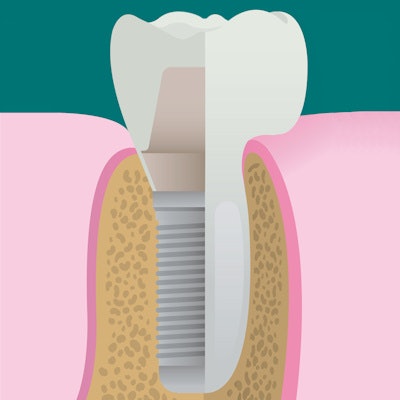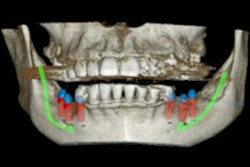
Silver and hydroxyapatite nanoparticles may be the key to reducing the implant failure rate. A new, biocompatible implant coated with the two materials effectively prevented biofilm growth and adhesion in a recent study.
To find the ideal implant surface, researchers from the University of Plymouth in the U.K. coated more than 80 disks with different combinations of silver and ceramic versions of hydroxyapatite. They published their findings in the journal Nanotoxicology (March 17, 2017).
"All the silver-plated disks had a strong antibiofilm activity as confirmed by the lack of biofilm development on the disk surfaces," wrote the authors, led by Alexandros Besinis, PhD, a lecturer in the university's School of Engineering. "Only a small number of scattered micro-organisms were detected with evident signs of limited cell division."
Promising disk coating
The majority of implant procedures are successful, but 5% to 10% still fail, most often because of peri-implantitis. Since biofilm formation often contributes to peri-implantitis, researchers are interested in finding ways to prevent the growth of harmful bacteria on implants and still bond with surrounding oral tissues. The study authors hypothesized that titanium implants modified with silver and a thin layer of ceramic may be able to accomplish both of those goals.
The researchers began by creating 81 disks out of a titanium alloy commonly used for implants, Ti6Al4V. They left nine of the disks untreated as controls (Ti), then coated the remaining 72 disks with eight different combinations of silver (Ag) nanoparticles, synthetic nanohydroxyapatite (nHA), and synthetic microhydroxyapatite (mHA). They chose those materials in particular because silver has an antibacterial effect, and hydroxyapatite is biocompatible and mimics the structure of bone and teeth.
Once the disks were coated, the researchers submerged six of the disks in each group in a solution of Streptococcus sanguinis for 24 hours. S. sanguinis is the bacteria most commonly responsible for peri-implantitis.
After 24 hours, the researchers measured how much bacteria grew on and adhered to each of the disks. The disks coated with silver had the strongest antimicrobial properties, preventing nearly all bacterial growth, they found. Out of the three disks with silver, the hybrid of silver and nanohydroxyapatite prevented the most bacterial growth and bacterial adhesion.

"Silver [nanoparticles] and silver ions have long been known for their antimicrobial activity against oral pathogens," the authors wrote. "A complete bacterial growth inhibition was achieved by the [silver + synthetic nanohydroxyapatite] and [silver + synthetic microhydroxyapatite] disks, whereas some growth was measured in the media hosting the Ag disks."
The strong performance of the hybrid disks is somewhat surprising considering that 30% more bacteria adhered to the disks coated in titanium and hydroxyapatite without silver than to the control disks. The authors believe this may be because when silver was added, it was slowly but effectively released from the hydroxyapatite disks, even more so than the disks coated in silver alone.
More trials needed
Although the findings look promising, the coating was only emerged in one strain of bacteria for 24 hours. Future studies will need to test how well the coating works over longer periods of time and when placed in human oral cavity cells, the authors noted.
However, they are hopeful that hybrid of silver and hydroxyapatite nanoparticles will improve implants, and they already see clinical uses.
"In terms of clinical safety and regulatory approval, this study demonstrates that the novel dual-layered composite used here is more effective at preventing bacterial growth than the traditional materials used for titanium implants," the authors concluded. "For the patient, this potentially offers a lowered infection risk without compromising the biocompatible [hydroxyapatite] surface required for successful osseointegration and accelerated bone healing."



















